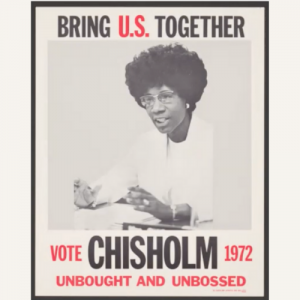Shirley Chisholm, Unbossed and Unbought

This lesson challenges students to explore feminism, female candidate campaigns, and gender inequality in America. Chisholm’s declaration of candidacy for President of the United States, along with a speech on the floor of the United States House of Representations, will allow students to investigate the words of Rep. Chisholm and how she sought to challenge injustice wherever she found it. In culmination, students will create a campaign commercial or a political advertisement for the 1972 Chisholm campaign that demonstrates her values and commitments, while writing a defense of the commercial.
30 minutes
Students, by engaging in a wide-ranging and diverse set of activities, will think critically about race, gender, women, and American political campaigns. This lesson will culminate in the creation of a political advertisement for Shirley Chisholm’s Presidential campaign.
1.Students will be able to analyze primary and secondary sources to better understand and feel historical empathy towards second-generation feminists and their struggle for equity.
2. Students will be able to analyze and synthesize primary and secondary sources to better understand the experience of women in the 1960s and 1970s.
3. Students will create and defend political advertisements of Representative Shirley Chisholm.
Students should be able to contextualize second-wave feminism in the context of the broader Civil Rights movements of the 1960s, and be aware of first-wave feminism and the fight for suffrage. Students should be familiar with the concept of intersectionality. For homework the prior night, students should read this profile from Shirley Chisholm from the National Women’s History Museum.
1. Transcript of Shirley Chisholm announcing her Presidential campaign
2. Speech on the floor of the House of Representatives from Representative Shirley Chisholm, “Equal Rights for Women.”
1. Do Now:
Use the Rapid-Fire Writing from Facing History and Ourselves to help students may sense of the following quote from Representative Shirley Chisholm:
“Of my two ‘handicaps’ being female put more obstacles in my path than being black.”
Once the Rapid-Fire Writing strategy has commenced, ask students to pair-up and share:
- Which word did they box? Why?
- How might the historical context of the 1960s shape then Representative Chisholm’s statement?
- What barriers may have prevented more women for running for political office in the past and the present?
2. Students should read aloud the transcript (located below) between Representative Shirley Chisholm announcing her run for President and a political reporter. This should be framed as a reflection on the impact women can have in public office. After reading the transcript, students should discuss the following questions in groups and then as a whole class. A video to Representative Chisholm’s entire announcement is available here
Discussion Questions for Small Groups
1. How does Representative Chisholm challenge the Nixon administration?
2. What do you think about the tone of the reporter’s questions? What does this reveal about American politics in 1972?
3. How does Representative Chisholm defend women, specifically black women, running for public office? In other words, how will electing more women change the roles and functions of the federal government?
3. In pairs, students will read a speech delivered by Shirley Chisholm on the floor of the United States House of Representatives. As they do, students should complete the following questions in their notebook. Teacher should check-in with students as they work (this assignment could also be completed in advance as pre-reading if the teacher is pressed for time)
Questions for Check for Reading
1. In her speech, Chisholm states, “a “calculated system of prejudice that lies unspoken.” To what extent do you see the remnants of this today? If so, where?
2. How does Chisholm compare prejudice for black Americans and women? Do you think Chisholm’s assessment is still accurate today? Why or why not?
3. What are two arguments against the Equal Rights Amendment as identified by Chisholm? How does Chisholm challenge them? To what extent do you find her arguments persuasive?
4. Exit Ticket: How did Shirley Chisholm changed and challenged the role of women in American society? In other words, what do you consider her legacy to be?
5. Following the Exit Ticket, the teacher should assign the homework below
Based on what you have learned today about Shirley Chisholm and her enduring legacy, consider the following activity:
Create an advertisement for Shirley Chisholm’s 1972 Presidential campaign. What themes, ideas, and messages would percolate based on her perspective, beliefs and worldview?
In addition to creating a political ad (it can be a campaign commercial, a poster, a radio ad, etc.), write a one-page defense of your ad using what you have learned.
Standards- C3 and Common Core
CCSS.ELA-LITERACY.RI.11-12.2 Determine two or more central ideas of a text and analyze their development over the course of the text, including how they interact and build on one another to provide a complex analysis; provide an objective summary of the text.
CCSS.ELA-LITERACY.RI.11-12.6 Determine an author’s point of view or purpose in a text in which the rhetoric is particularly effective, analyzing how style and content contribute to the power, persuasiveness, or beauty of the text.
CCSS.ELA-LITERACY.RH.11-12.4 Determine the meaning of words and phrases as they are used in a text, including analyzing how an author uses and refines the meaning of a key term over the course of a text (e.g., how Madison defines faction in Federalist No. 10).
D2.His.4.9-12.
Analyze complex and interacting factors that influenced the perspectives of people during different historical eras.
D2.His.3.9-12. Use questions generated about individuals and groups to assess how the significance of their actions changes over time and is shaped by the historical context.
D2.His.1.9-12
Evaluate how historical events and developments were shaped by unique circumstances of time and place as well as broader historical contexts.
